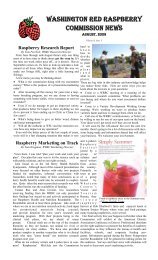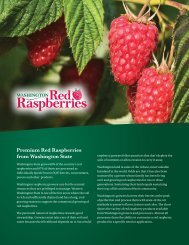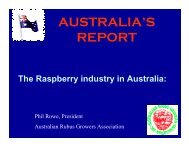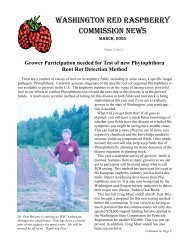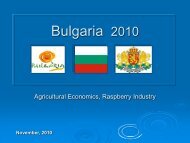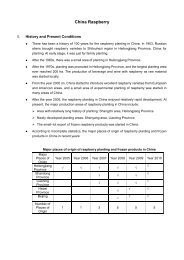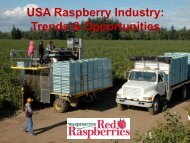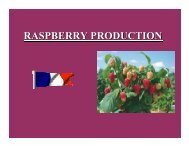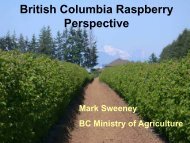2012 - Washington Red Raspberry Commission
2012 - Washington Red Raspberry Commission
2012 - Washington Red Raspberry Commission
Create successful ePaper yourself
Turn your PDF publications into a flip-book with our unique Google optimized e-Paper software.
Importantly, floricane injury and berry harvest have not been significantly impacted by these<br />
applications. Since postemergence (POST) treatments can be made when weeds are visible and<br />
thus to areas known to be infested with perennial weeds, cost of these treatments may be<br />
significantly lower than broadcast applications to the full block. Additionally, if good to<br />
excellent weed control results from these applications, slight crop injury due to the herbicide is<br />
more acceptable if it occurs only on selected areas of the field. More reliable crop injury data<br />
resulting from applications of these products is needed to document that they are safe for use in<br />
raspberry if registrations are to result, however. Treevix (BASF) and Alion (Bayer) are two new<br />
herbicides that recently gained federal registrations in certain orchard crops. Initial data in<br />
raspberry is promising, with Treevix as a cane burning herbicide similar in activity to Goal<br />
(oxyfluorfen) and Alion providing residual control of germinating weed seeds.<br />
Dr. Ed Peachey at Oregon State University is also conducting herbicide work in red<br />
raspberry, with both of us conducting preliminary crop safety (nonresidue) trials with IR-4 with<br />
Facet. We are also cooperating with Dr. Doug Doohan at Ohio State University on our<br />
investigations with Stinger. I am unaware of any weed management projects in raspberry<br />
occurring in Idaho or British Columbia.<br />
Relationship to WRRC Research Priority(s): #2 Priority, Weed Management<br />
Objectives (2013): To test several non-labeled herbicides in various sequences or mixtures for<br />
control of several perennial weeds in established red raspberries.<br />
Procedures:<br />
Plots will be established in 2013 in established raspberries. Herbicide applications will<br />
be made for several combinations of herbicides at cane burning time in early spring (Treevix and<br />
Alion) and late spring (Stinger and Facet). A typical application sequence could be Treevix +<br />
Alion in April followed by Stinger in late May. Most sequences/combinations of these<br />
herbicides will be included in this trial, as well as combinations and sequences with other<br />
common residual herbicides such as Sinbar (terbacil), simazine, diuron, and Callisto<br />
(mesotrione). Weed control will be evaluated, as will herbicide effects on raspberry yield, berry<br />
size, and primocane growth.<br />
Anticipated Benefits and Information Transfer: (100 words maximum)<br />
If positive, data from this experiment will be used to support new herbicide registrations<br />
in raspberries for these products. The data resulting from these studies will be disseminated<br />
through extension bulletins and during grower meetings sponsored by extension faculty and the<br />
agricultural industry.<br />
070



